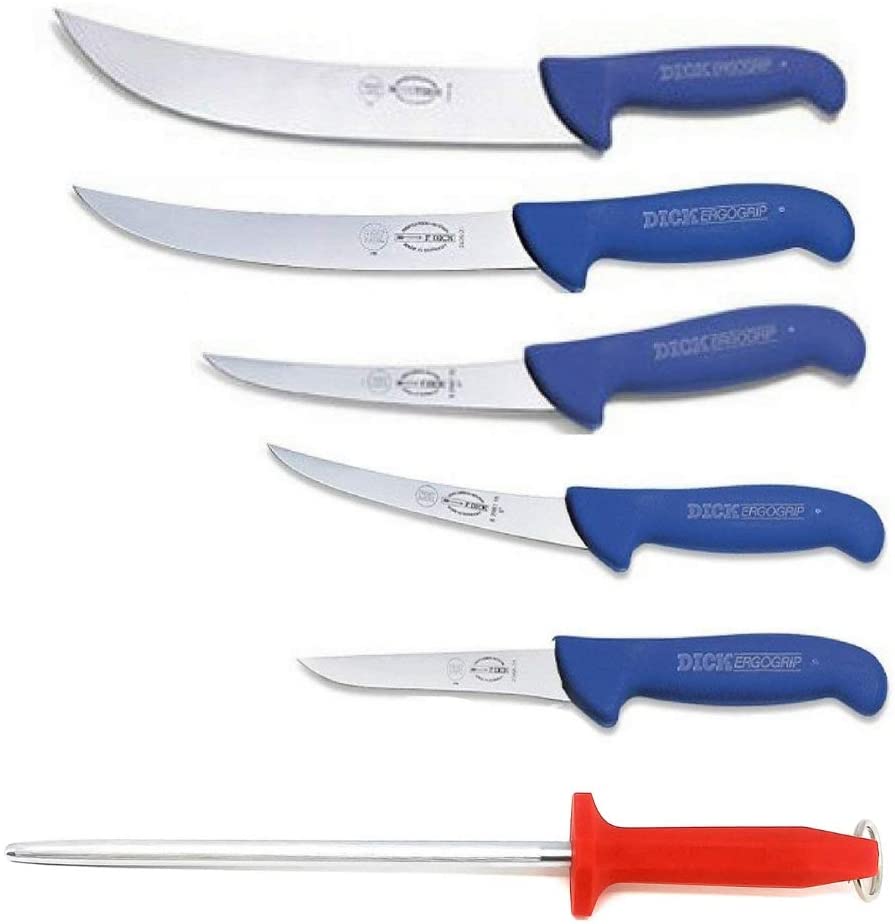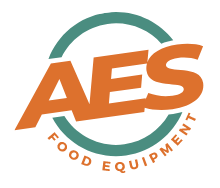The backbone of any butcher’s work lies in their tools, and having the right butchery equipment can make all the difference. From butcher's knives to specialised cutting tools, investing in high-quality, durable equipment ensures precision, efficiency, and safety in every task.
The Must-Have Knives for Butchers
Every butcher’s toolkit starts with the right butcher's knives. Here are a few essentials:
- Boning Knife: Perfect for removing bones from meat with precision.
- Breaking Knife: Designed to break down large sections of meat.
- Cimeter Knife: Ideal for slicing steaks and trimming fat.
Each knife is crafted with a specific purpose in mind, allowing butchers to work efficiently without compromising on quality.
Supporting Tools to Enhance Efficiency
Beyond knives, other tools play a critical role in butchery. Essential items include:
- Sharpening Steels: Keep your knives razor-sharp for consistent cuts.
- Cutting Boards: Opt for hygienic, durable surfaces to maintain cleanliness.
- Scabbards and Knife Racks: Safe and convenient storage options to protect your tools.
Why Quality Matters in Butchery Equipment
Investing in premium butchery equipment not only enhances performance but also reduces long-term costs. High-quality knives and tools are designed to withstand rigorous daily use, ensuring they remain effective for years to come.
Maintaining Your Tools for Longevity
Regular maintenance is key to getting the most out of your equipment. Ensure you properly clean, sanitise, and store your butcher's knives and tools after each use. Consider using specialised knife washers, available in our hygiene equipment range, to guarantee thorough cleaning.
With the right tools in your arsenal, you can elevate your butchery operations and deliver exceptional results for your customers. Browse our full range of butchery equipment here.
In the world of butchery, precision is key. Whether you're working in a commercial setting or a smaller shop, the right tools can make all the difference. Butchers knives are essential for efficiently processing meat, ensuring clean cuts, and reducing waste. In this guide, we’ll help you navigate the different types of butcher knives available, so you can choose the best tools for your meat business.
1. Breaking Knives
Breaking knives are designed for cutting large sections of meat into more manageable portions. Their long, curved blades allow for smooth cuts that reduce strain on the user and maintain the integrity of the meat. These knives are perfect for breaking down whole carcasses or large sections of beef or pork.
- Recommended Blade Length: A breaking knife typically has a blade length of 10 to 12 inches, allowing for ample leverage when cutting through thick muscle and fat.
- Key Features: Look for ergonomic handles that provide a secure grip and reduce fatigue during prolonged use.
2. Boning Knives
A boning knife is a must-have for removing bones from cuts of meat. Available in flexible, semi-flexible, and stiff varieties, these knives are essential for achieving precise cuts while minimising waste. A flexible boning knife is ideal for poultry and fish, while a stiffer blade works best for larger cuts like beef.
- Choosing the Right Boning Knife: For intricate work around joints and ribs, a flexible knife is ideal. For larger cuts, a semi-stiff blade provides better control.
- Techniques: Mastering the proper technique for boning will enhance efficiency and yield, reducing the amount of meat left on the bone.
3. Butcher Cleavers
When it comes to heavy-duty tasks like splitting bones, a cleaver is indispensable. Its weight and sturdy design make it the perfect tool for cutting through tougher cuts of meat and bones. For any high-volume meat processor, a reliable cleaver will increase efficiency in the kitchen.
- Types of Cleavers: There are traditional Chinese cleavers, which are versatile and great for various tasks, and heavier Western-style cleavers, designed primarily for breaking bones.
- Safety Tips: Always use a cleaver on a sturdy cutting board to prevent slipping and accidents.
4. How to Choose the Right Knife
Choosing the right knife depends on the type of meat you work with and the volume of your operation. Consider whether you need flexible or stiff blades, the handle’s ergonomics for long periods of use, and the overall durability of the knife. Investing in high-quality knives can reduce long-term costs by lasting longer and requiring less maintenance.
- Factors to Consider:
- Material: Stainless steel offers corrosion resistance and durability, while carbon steel provides sharper edges but requires more maintenance.
- Weight: Heavier knives provide more force but can lead to fatigue; lighter knives offer precision but may require more effort for tough cuts.
5. Maintaining Your Butchers Knives
To keep your knives in peak condition, regular maintenance is key. This includes sharpening after every few uses, using a honing steel, and cleaning with hot water and detergent. Proper care not only extends the life of your knives but also ensures that your cuts remain precise.
- Sharpening Techniques:
- Whetstones: A traditional method that allows for precise sharpening.
- Honing Rods: Useful for maintaining the edge between sharpenings.
- Storage Solutions: Consider magnetic strips or knife blocks to keep your knives organised and protected from damage.
Check out our selection of butcher knives at AES Food Equipment today, your number one partner for quality food equipment and supplies.
When it comes to butchering, the right tools can make all the difference. Butchers knives are a cornerstone of any meat processing operation, designed for precision, efficiency, and safety. Whether you're working in a commercial abattoir, a busy butcher's shop, or even handling meat at home, it’s good to understand the different types of butcher knives. In this guide, we’ll break down the key knives every butcher should have in their toolkit, helping you choose the best tools for your needs.
Understanding Butchers Knives: The Basics
Butcher knives are not one-size-fits-all. Each knife is tailored for specific tasks, whether it’s breaking down large carcasses or making fine cuts for perfect presentation. There are three primary categories you’ll want to be familiar with: breaking knives, boning knives, and butcher’s cleavers. Each of these knives is essential for various stages of meat processing.
- Breaking Knives: Designed for Precision
Breaking knives are the first step in meat processing, used to divide carcasses into smaller sections. Their long, curved blades provide excellent control and precision, ensuring clean cuts through large portions of meat without damaging muscle fibres. A high-quality breaking knife is a must-have for professional butchers handling larger quantities of meat.
- Boning Knives: Flexibility and Accuracy
The boning knife is designed for delicate work, allowing butchers to remove bones from meat with ease. With a narrow, curved blade, boning knives come in varying degrees of flexibility, depending on whether you are working with beef, pork, or poultry. A stiff blade is perfect for beef, while a more flexible option is ideal for poultry and fish.
- Cleavers: Power for Tough Jobs
No butcher’s toolkit is complete without a cleaver. This heavy-duty knife is perfect for splitting bones and large pieces of meat. Its weight and sturdy construction allow for maximum force when breaking through tougher cuts, making it indispensable for processing larger animals.

Choosing the Right Butchers Knives for Your Needs
Selecting the right knife depends on the type of work you do. For commercial operations like abattoirs and butchers, durability and ease of sharpening are key factors. On the other hand, smaller butchers or home butchers may prioritise flexibility and comfort. Whichever category you fall into, investing in high-quality butcher knives ensures better performance and longevity.
Maintenance and Care for Butchers Knives
To keep your knives in top condition, regular maintenance is essential. This includes sharpening, cleaning, and proper storage. Stainless steel knives are popular for their resistance to rust, but all blades benefit from frequent sharpening to maintain their edge. Using a honing steel after each use helps keep your knives sharp, while regular deep cleaning and sanitising ensure food safety standards are met.
Conclusion
A well-equipped butcher’s toolkit is essential for ensuring both precision and efficiency in meat processing. By choosing the right butcher knives and maintaining them properly, you can improve your workflow and enhance the quality of your cuts. Whether you’re a professional in the meat industry or an enthusiast looking to handle meat at home, investing in the best tools will make all the difference.
Discover our butchery knives today. We stock a range of top quality butchery knives for all of your meat processing needs.
